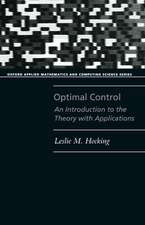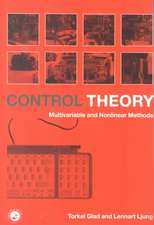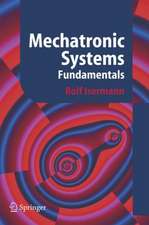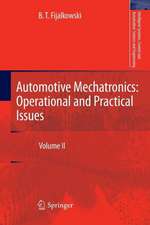Nonlinear System Identification: From Classical Approaches to Neural Networks and Fuzzy Models
Autor Oliver Nellesen Limba Engleză Hardback – 6 noi 2000
| Toate formatele și edițiile | Preț | Express |
|---|---|---|
| Paperback (1) | 721.53 lei 6-8 săpt. | |
| Springer Berlin, Heidelberg – 15 dec 2010 | 721.53 lei 6-8 săpt. | |
| Hardback (2) | 703.85 lei 3-5 săpt. | |
| Springer International Publishing – 30 sep 2022 | 703.85 lei 3-5 săpt. | |
| Springer Berlin, Heidelberg – 6 noi 2000 | 975.10 lei 6-8 săpt. |
Preț: 975.10 lei
Preț vechi: 1189.16 lei
-18% Nou
Puncte Express: 1463
Preț estimativ în valută:
186.61€ • 194.10$ • 154.06£
186.61€ • 194.10$ • 154.06£
Carte tipărită la comandă
Livrare economică 14-28 aprilie
Preluare comenzi: 021 569.72.76
Specificații
ISBN-13: 9783540673699
ISBN-10: 3540673695
Pagini: 808
Ilustrații: XVII, 786 p.
Dimensiuni: 156 x 234 x 47 mm
Greutate: 1.3 kg
Ediția:2001
Editura: Springer Berlin, Heidelberg
Colecția Springer
Locul publicării:Berlin, Heidelberg, Germany
ISBN-10: 3540673695
Pagini: 808
Ilustrații: XVII, 786 p.
Dimensiuni: 156 x 234 x 47 mm
Greutate: 1.3 kg
Ediția:2001
Editura: Springer Berlin, Heidelberg
Colecția Springer
Locul publicării:Berlin, Heidelberg, Germany
Public țintă
GraduateCuprins
1. Introduction.- I. Optimization Techniques.- 2. Introduction to Optimization.- 3. Linear Optimization.- 4. Nonlinear Local Optimization.- 5. Nonlinear Global Optimization.- 6. Unsupervised Learning Techniques.- 7. Model Complexity Optimization.- II. Static Models.- 9. Introduction to Static Models.- 10. Linear, Polynomial, and Look-Up Table Models.- 11. Neural Networks.- 12. Fuzzy and Neuro-Fuzzy Models.- 13. Local Linear Neuro-Fuzzy Models: Fundamentals.- 14. Local Linear Neuro-Fuzzy Models: Advanced Aspects.- III. Dynamic Models.- 16. Linear Dynamic System Identification.- 17. Nonlinear Dynamic System Identification.- 18. Classical Polynomial Approaches.- 19. Dynamic Neural and Fuzzy Models.- 20. Dynamic Local Linear Neuro-Fuzzy Models.- 21. Neural Networks with Internal Dynamics.- IV. Applications.- 22. Applications of Static Models.- 23. Applications of Dynamic Models.- 24. Applications of Advanced Methods.- A. Vectors and Matrices.- A.1 Vector and Matrix Derivatives.- A.2 Gradient, Hessian, and Jacobian.- B. Statistics.- B.1 Deterministic and Random Variables.- B.2 Probability Density Function (pdf).- B.3 Stochastic Processes and Ergodicity.- B.4 Expectation.- B.5 Variance.- B.6 Correlation and Covariance.- B.7 Properties of Estimators.- References.
Caracteristici
Easy and intuitive understanding Explanations and terminology from an engineering point-of-view Only basic mathematics required Self-contained, no other literature needed Includes supplementary material: sn.pub/extras
Notă biografică
Oliver Nelles was born in Frankfurt (Main), Germany, and got his Master’s and Ph.D. degree in Electrical Engineering and Automatic Control at the Technical University of Darmstadt. After being a Post-Doc at the Department of Mechanical Engineering at UC Berkeley he worked for Siemens VDO Automotive in Regensburg. During his five years in Regensburg he was project and group leader in the field of transmission control. Since 2004 he assumed a position as Professor for Automatic Control – Mechatronics at the University of Siegen. Oliver Nelles’ key research areas are: machine learning, system identification, nonlinear dynamic systems & control, design of experiments (DoE), fault diagnosis.
Textul de pe ultima copertă
This book provides engineers and scientists in academia and industry with a thorough understanding of the underlying principles of nonlinear system identification. It equips them to apply the models and methods discussed to real problems with confidence, while also making them aware of potential difficulties that may arise in practice.
Moreover, the book is self-contained, requiring only a basic grasp of matrix algebra, signals and systems, and statistics. Accordingly, it can also serve as an introduction to linear system identification, and provides a practical overview of the major optimization methods used in engineering. The focus is on gaining an intuitive understanding of the subject and the practical application of the techniques discussed. The book is not written in a theorem/proof style; instead, the mathematics is kept to a minimum, and the ideas covered are illustrated with numerous figures, examples, and real-world applications.
In the past, nonlinear system identification was a field characterized by a variety of ad-hoc approaches, each applicable only to a very limited class of systems. With the advent of neural networks, fuzzy models, Gaussian process models, and modern structure optimization techniques, a much broader class of systems can now be handled. Although one major aspect of nonlinear systems is that virtually every one is unique, tools have since been developed that allow each approach to be applied to a wide variety of systems.













